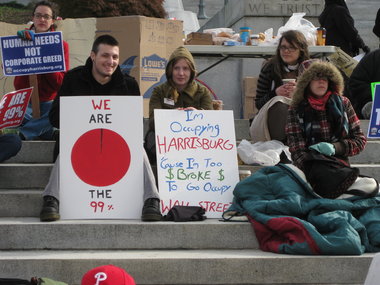The image that sticks out most in mind from time spent at the Occupy Wall Street protests was a mask. Sitting on pavement, a protester was wearing a Guy Fawkes mask. Aware of the protesters’ supporters support of the government–the Obama portion, that is–I asked, “Why Guy Fawkes?” He looked at me as if I was the saddest thing on earth and said, “Dude, this is ‘V For Vendetta.'”
This is more grist for the mill for those who see the protesters as illiterate jargon merchants, for only someone who opened a book on English history would know who Fawkes was; knowledge of ‘V’ is obtainable by watching the film based on the graphic novel by Alan Moore. The protesters either haven’t thought through their fashion statement, or they do not have the mental capacity or attention span to grasp what either pop culture representation of Fawkes was about. ‘V for Vendetta’ concerns the exploits of a superhero type against a British fascist government. He accomplishes what Falkes only tried to do: he blows up Parliament–Parliament, mind you, not a financial center. In the film, this moment is presented glamorously as V sails through the air against the backdrop of the explosion.
Clearly it is this image–not the target of the explosion, but the fact that something is blowing up–that has the protesters donning the mask. They, too, want to detonate a building, preferably one on Wall Street. V, in entrancing slow motion, skewers cops; they too are begging for the chance to emulate this.
But there the resemblances end.
V and Fawkes were against the government as a whole, not just its financial manifestations. The protesters seek the re-election of their President and want the government to use force against the business community. Indeed, if there is any link between them and the film, it is how they resemble the fascists. The regime of V came into power because of a violent extremist street gang specializing in blaming Jewish capitalists; what better definition of the OWS movement than this?
The uniqueness of OWS becomes apparent when one attempts to find a replacement mask. Lenin? He exhibited the same violent goal but it was against the government as a whole. Hitler? Okay on the anti-semitism, but he, too, was against the government. Castro? Certainly; after he came to power, he shot bushels of United Fruit corporate workers in a football stadium, but that still denies the protesters the beauty of an explosion. In that regard, the best mask for them would be that of Luigi Galleani, a World War I-era anarchist who advocated the “theory of the deed,” i.e the use of violence to eliminate class enemies. In 1920, his followers orchestrated a bombing of Wall Street.
None of this gives any comfort to the bystanders, for the protesters’ inability to find a relevant mask means that the one they have can only correspond to its source material in any meaningful way if violence is committed.

COMMENTS
Please let us know if you're having issues with commenting.